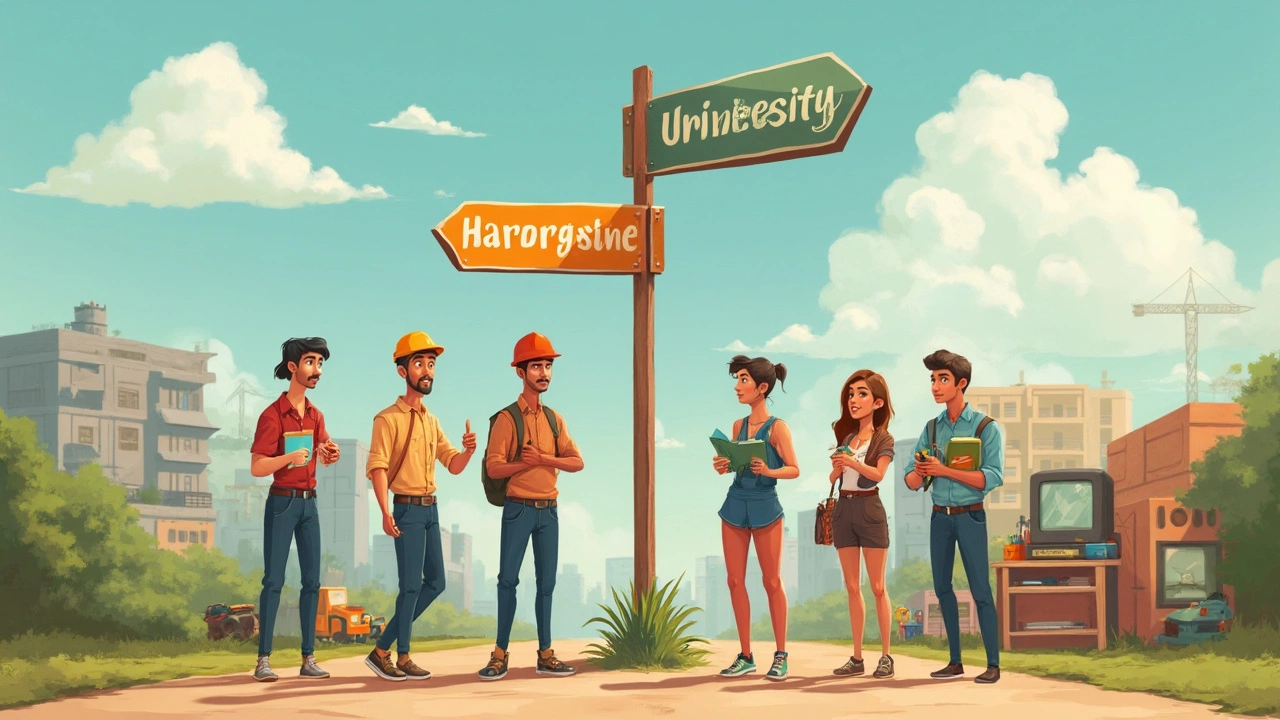Most people use the words “vocational” and “educational” like they mean the same thing, but let’s not pretend school and hands-on job training are just two sides of the same coin. When you’re picking your path, you want to know exactly what you’re signing up for and not get lost in confusing, school-counselor talk.
Here’s the deal: vocational means learning a specific skill to get working fast—think being a plumber, hair stylist, or electrician. Educational? That’s your typical classroom stuff—math, literature, maybe a dash of philosophy—gearing you up for a degree, not a direct job. You’ll hear “vocational” thrown around when someone’s talking about practical skills and actually getting a paycheck soon after. On the flip side, “educational” often means you might be collecting diplomas before seeing your first real paycheck.
If you’re at a crossroads and aren’t sure which way to go, it pays to understand how these paths impact your wallet, your daily life, and your long-term options. Let’s get these terms straight, so choosing what’s best for you is less of a gamble and more of a smart move.
- Defining Vocational and Educational Paths
- How They Train You Differently
- Real-World Examples That Hit Home
- Who Thrives in Each Path?
- Tips for Making the Smart Choice
- Biggest Myths People Still Believe
Defining Vocational and Educational Paths
Let’s clear up what everyone actually means by “vocational” and “educational.” These words get tossed around so much that it’s easy to mix them up, but they mean totally different things, especially when planning your future.
Vocational is all about teaching you practical skills for a specific job. Courses focus on trades like automotive repair, healthcare tech, or culinary arts. You’ll do hands-on stuff—using real tools, working on actual equipment, and often learning from people still active in the field. The main goal? Get you job-ready as fast as possible. Most vocational courses take between a few months to two years.
Educational paths—think high school, college, or university—cover broader subjects. You might take history, math, science, or the arts. There’s a heavier focus on theory and broad knowledge, with less gear toward a single career right away. Earning a traditional degree usually takes at least three or four years, and you might not touch the actual job until you’ve finished everything.
- Vocational = specialized, job-specific training, often at technical schools or community colleges.
- Educational = general, theory-based learning, usually at high schools and universities.
Here’s how they stack up when you compare the two directly:
| Path | Main Focus | Typical Length | Outcome |
|---|---|---|---|
| Vocational | Direct work skills | 3 months – 2 years | Ready to start job |
| Educational | Theory and broad learning | 2 – 4+ years | Degree or diploma |
If you type “vocational” into a job search site, you’ll see stuff like electrician programs, dental assistant courses, or coding bootcamps popping up. Google “educational,” and it’s all degrees, lectures, and diplomas. These choices shape your work life in big ways, so knowing the difference is a game changer.
How They Train You Differently
If you start a vocational course, get ready to roll up your sleeves—because most of your learning happens by actually doing the stuff you’ll be paid for someday. This isn’t sitting at a desk listening to theory all day. Vocational training jumps right into using tools, running machines, or following real procedures. For example, a future welder will be welding, not just watching PowerPoints about welding.
In educational programs, things look pretty different. You’re usually getting the bigger picture—the “why” behind the “how.” This means lots of lectures, essays, and tests, with the focus more on broad knowledge than a specific job. The idea is you build a strong foundation that’s useful almost anywhere, but it might not tie directly to a job you can start right away.
Here’s a quick look at how classroom time stacks up:
| Type of Program | Hands-On Training | Classroom Learning |
|---|---|---|
| Vocational | 70-90% | 10-30% |
| Educational | 10-20% | 80-90% |
Another fun fact—vocational courses often include real-world placements like apprenticeships or internships, so you start building your resume right away. That’s a shortcut into the job market. At universities, plenty of students graduate without ever setting foot in their actual future workplace.
If you like learning by doing (and not just reading), vocational training is probably your sweet spot. But if you prefer understanding a broad range of subjects or covering the why behind the things, educational programs set you up for that endless curiosity and career flexibility.
Real-World Examples That Hit Home
It’s easy to get lost in theory, so let’s talk about how these two paths look in actual workplaces. Take a kid who decides to become an auto mechanic instead of going to college. They hit a vocational school, spend maybe 18 months getting real hands-on training, and land a job in a repair shop at age 20. By 23, they’re working full-time and probably out-earning some friends who went the university route and are still chasing internships.
Now, picture their classmate who chose the “educational” path—four years of college. Maybe they major in history and graduate at 22 or 23. They’ve learned a lot, sure, but grabbing a job straight out of school isn’t always easy. On average, almost 30% of grads work jobs that don’t require a degree at all (check the U.S. Bureau of Labor Statistics for proof).
If health care’s your thing, the same line runs through nursing. Vocational program? Two years as a licensed practical nurse (LPN) and you can get working fast. College? A four-year Bachelor of Science in Nursing (BSN) might land you more doors eventually, but it’ll take more time and money upfront.
- Vocational training is the go-to for fields like electrician, dental hygienist, chef, or HVAC technician.
- Educational paths fit if you’re looking toward jobs like lawyer, teacher, engineer, or psychologist—anything that straight-up requires a degree.
Here’s a quick peek at how things shake out for real jobs and salaries:
| Job | Vocational or Educational | Average Time to Enter Field | Median Annual Salary (2024, US) |
|---|---|---|---|
| Electrician | Vocational | 2-4 years (apprenticeship) | $60,240 |
| Registered Nurse (BSN) | Educational | 4 years (degree) | $81,220 |
| Dental Hygienist | Vocational | 2-3 years | $77,810 |
| Software Developer | Educational | 4+ years | $127,260 |
| Auto Mechanic | Vocational | 1-2 years | $47,170 |
The pattern’s pretty clear. If you want a job fast with solid income, vocational training is hard to beat for a bunch of careers. If your goal is a profession that demands a degree, the longer educational path’s the only route. At the end of the day, both tracks are legit—it really depends what you’re looking for.

Who Thrives in Each Path?
The biggest mistake people make is thinking anyone can fit into any kind of training or learning style. That’s just not true. Some folks absolutely fly through vocational courses, while others only hit their stride in a traditional classroom. Each path really brings out the best in a certain kind of person, so let’s break it down:
Vocational students tend to be hands-on learners. They like getting started right away and want a straight shot to a job. These people are usually doers—they want to see instant results and prefer tackling real-world problems over sitting through theory-heavy lectures. They’re often in a hurry to earn money, support their families, or just don’t want to rack up huge student debt. In fact, a 2023 survey from NCES showed that nearly 85% of adult learners taking vocational courses picked them because they offer a clear, fast route to a job with decent pay.
On the other hand, the traditional educational path suits folks who like digging deep, asking questions, and exploring lots of different ideas. These learners usually have the patience for a few years in school and sometimes aim for jobs that need advanced degrees—think engineers, teachers, or researchers. They’ll often put up with more theory and exams because they’re banking on a bigger long-term payoff or the flexibility to switch careers later.
Some quick stats:
| Path | Who Excels | Average Time to Job | Job Flexibility |
|---|---|---|---|
| Vocational | Hands-on, focused, eager to work | 6 months - 2 years | Specific, fast entry but more focused fields |
| Educational | Analytical, theory-driven, patient | 2 - 4 years or more | Broader, more open-ended options |
Are you someone who loves rolling up your sleeves and getting straight to business? Or do you find satisfaction puzzling things out and taking time to master a field? Be honest with yourself and match your strengths to where you’ll thrive—it can save you time, stress, and even money.
- If you’d rather fix a car than read about how one works, vocational paths might suit you best.
- If you want a shot at management, research, or teaching, the educational route lays the right groundwork.
- For people who are undecided, try job shadowing or internships to see where you feel more at home. These real-world tryouts often say more than any career quiz ever could.
Tips for Making the Smart Choice
Don’t overthink it—when you’re torn between a vocational route and a traditional educational path, a few key details can tip the scales. It starts with knowing your own goals, and then matching them to what each path really gives you.
- Think about how fast you want to start working. If you want a steady job sooner, vocational courses are usually much quicker. For example, a welding certificate can take 6-12 months, while a bachelor’s degree usually takes four years.
- Check the numbers. According to the U.S. Bureau of Labor Statistics (2024), people in many vocational trades can earn $50,000 or more a year—even without a degree. Don’t buy into the myth that only college grads earn a decent living.
- Look at demand. Here’s some eye-opening data from last year:
| Career | Entry Route | Median Wage (2024) | Job Openings (2024) |
|---|---|---|---|
| Electrician | Vocational | $60,240 | 73,500 |
| Registered Nurse | Educational | $81,220 | 193,100 |
| HVAC Technician | Vocational | $51,390 | 37,700 |
| Elementary Teacher | Educational | $63,500 | 110,900 |
Notice how both paths open up jobs with solid paychecks. Some trades are seriously in demand because not enough people are coming up through vocational training.
- Consider your learning style. Hate sitting in lectures and reading textbooks? Vocational training is hands-on. Love research and writing papers? Education-based courses will fit better.
- Factor in your lifestyle and budget. Tuition for a vocational program is way lower, and you’ll probably have less student debt. Very few people want a monthly loan bill hanging over them for years.
- Don’t listen to old clichés. Vocational programs aren’t a “backup” or a consolation prize. They’re legit pathways to careers that can’t be outsourced and get respect in today’s job market.
Bottom line: Shortlist a few careers, talk to people in those jobs, tour campuses, and dig deep into job stats for your area. You get one shot at choosing your launchpad, so make sure it lines up with what actually matters to you now and five years from now.
Biggest Myths People Still Believe
We need to kick a few myths to the curb. Some ideas about vocational and educational tracks stick around way longer than they should, even though they don’t match up with reality anymore.
Let’s get real about the biggest ones:
- Myth: Vocational training is just for people who couldn't handle school. This one is just plain wrong. Modern vocational programs require real problem-solving and technical skills. Some careers—think medical techs or advanced manufacturing—need just as much smarts as a traditional degree.
- Myth: Choosing vocational means less pay and opportunity. Take a look at the facts. According to the U.S. Bureau of Labor Statistics, some trades pay more than jobs you get with a bachelor’s. Elevator installers average over $80,000 per year, which beats a lot of office gigs.
- Myth: Academic education guarantees a stable job. Plenty of graduates with four-year degrees end up underemployed or working in unrelated jobs. The job market wants skills; sometimes a focused certificate wins over a diploma when it comes to hiring.
- Myth: Vocational skills go out of date fast. Sure, tech changes, but there’s always demand for skilled builders, welders, mechanics, or healthcare workers. Vocational schools even update their training faster than universities update their syllabuses.
Let’s get down to the data, just in case anyone’s still not convinced:
| Path | Average Time to First Job | Median Annual Pay* | Job Growth 2022–2032 |
|---|---|---|---|
| Vocational | 6–18 months | $48,000 | 5–10% |
| Traditional Degree | 4+ years | $62,000 | 3–7% |
*Numbers from U.S. BLS and National Center for Education Statistics, 2024
So if you’re thinking vocational training isn’t as respectable or useful, the numbers say otherwise. Don’t let old-school thinking keep you from a smart career move.





